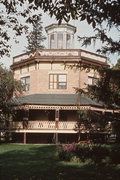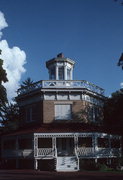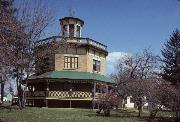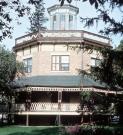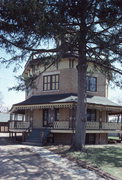| Additional Information: | A 'site file' exists for this property. It contains additional information such as correspondence, newspaper clippings, or historical information. It is a public record and may be viewed in person at the Wisconsin Historical Society, State Historic Preservation Office.
Wisconsin has more octagonal houses than any state except Massachusetts or New York. Today they seem archaic, but in their time they incorporated the latest construction techniques and mechanical systems. Phrenologist and writer Orson Fowler of New York promoted his octagonal plans for their efficient use of space and materials and their supposedly positive effects on personal well-being in his book A Home for All, or a New, Cheap, Convenient, and Superior Mode of Building, first published in 1848. Fowler’s followers were innovative thinkers attracted to the efficiency and novelty of Fowler’s design.
Edward Elderkin patterned his on “Howland’s Octagonal Plan,” which appeared in the 1854 edition of Fowler’s book. Nonetheless, the Italianate details and the scale and design of the enormous cupola were Elderkin’s own. Rising two stories from a raised basement, its buff and pink brick walls up to sixteen inches thick, this prosperous local lawyer’s house was one of the most substantial structures in the twenty-year-old village. Paired windows, some of them blind, pierce each side. A veranda encircles the first story, with an unusual double-loop pattern in its railing and a dropped-circle design in its frieze. At the roofline, heavier geometric detailing predominates, with scroll-sawn brackets and a chevron railing. The entire composition culminates in a 16-foot-tall cupola, built of hand-hewn timbers, glazed with tall multipaned windows, and crowned by a bracketed cornice. From its center emerges an enormous brick chimney with four flues. Inside his house, Elderkin installed new technology, including a network of speaking tubes.
Col. Elderkin was an attorney who owned a large section of land in the area. |
|---|
| Bibliographic References: | Buildings of Wisconsin manuscript.
JANESVILLE GAZETTE 4/27/1994.
Janesville Gazette 6/21/1938.
Wisconsin State Journal 9/9/1951.
Milwaukee Journal 9/28/1956.
Milwaukee Journal 10/12/1965.
Janesville Gazette 5/5/1966.
Milwaukee Journal 4/7/1968.
Janesville Gazette 10/1974.
Elkhorn Independent 11/1/2001.
A Walking Tour of Elkhorn, Wisconsin. Elkhorn Preservation Commission, Elkhorn, Wis. Undated.
Perrin, Richard W. E., Historic Wisconsin Architecture, First Revised Edition (Milwaukee, 1976). |
|---|

